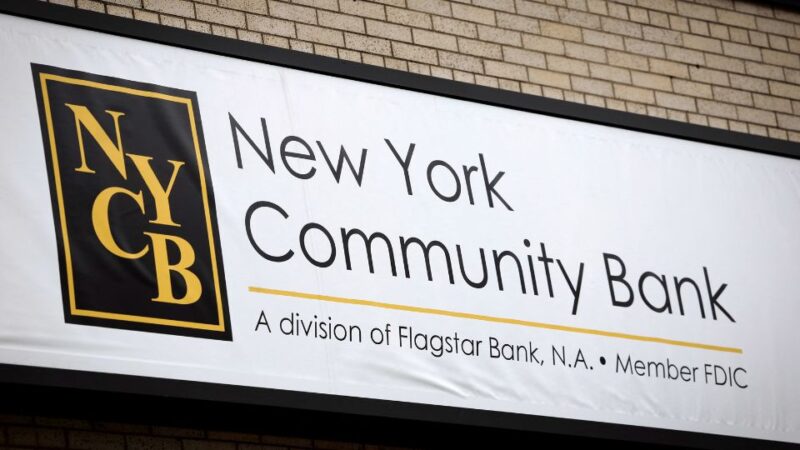The saga of CRE lender NYCB took a dramatic turn this Thursday with the announcement of CEO Thomas Cangemi’s departure after 27 years of service.
The recent developments at New York Community Bancorp (NYCB) have caught the financial world’s attention. The current situation marks a significant period of turmoil and challenge for the renowned commercial real estate lender.
CRE Lender NYCB Faces Leadership Shake-Up and Financial Reassessment
The saga of NYCB took a dramatic turn this Thursday with the announcement of CEO Thomas Cangemi’s departure after 27 years of service. This leadership change, coupled with the revelation of internal control weaknesses and a staggering tenfold increase in the fourth-quarter loss to $2.7 billion, underscores the challenges facing the Hicksville, N.Y.-based institution.
Following these shocking disclosures, CRE Lender NYCB’s stock experienced a precipitous 28% fall in premarket trading on Friday. This decline is a testament to the growing investor concerns over the bank’s financial health and its ability to navigate through this higher interest rate market environment.
Only a year after playing a crucial role as a rescuer during the 2023 regional banking crisis, NYCB finds itself in the midst of its own crisis. The bank’s decision in January to cut its dividend, increase loan loss provisions, and report a significant quarterly loss marked the beginning of a troubling trend that has only intensified with the latest disclosures.
In a recent filing, NYCB disclosed a new $2.4 billion goodwill impairment charge, a decision stemming from a reassessment of the value of historical transactions. This substantial charge has necessitated a revision of the fourth-quarter loss to the alarming figure of $2.7 billion, further complicating the bank’s financial outlook.
Related: Understanding CRE CLOs Amid Rising Distress Waves in 2024
Leadership and Board Changes: A New Chapter for CRE Lender NYCB
The departure of Thomas Cangemi from his role as CEO of NYCB marks a significant leadership transition for the bank amid its financial and regulatory challenges. Cangemi played a pivotal role in guiding the bank through various phases of growth and challenges.
His decision to step down and remain on the board reflects a moment of significant change for NYCB. In his stead, Alessandro DiNello has been appointed as the new leader, assuming the position of executive chairman.
DiNello, with a notable background as the former CEO of Troy, Mich.-based Flagstar Bank—a financial institution that NYCB acquired at the end of 2022—brings a wealth of experience to his new role.
Before his tenure at Flagstar, DiNello had accumulated extensive experience in banking and financial services. NYCB hopes that this experience will equip him with the tools to navigate NYCB through its current challenges and opportunities.
During a conference call on February 7, Alessandro DiNello addressed analysts’ concerns, emphasizing the bank’s proactive stance in managing its current challenges. He affirmed, “We’ll be laser-focused” on diminishing NYCB’s commercial real estate concentration. DiNello also highlighted that the foremost goal for NYCB is “building confidence” among Wall Street investors regarding its deposit stability and liquidity.
His leadership comes at a crucial time as NYCB seeks to address its recent turmoil and set a course for recovery and growth.

From Rescuer to Troubled Waters: The Journey of CRE Lender NYCB
NYCB embarked on its significant expansion by acquiring Flagstar Bank in 2023. It also integrated assets from the defunct Signature Bank, which elevated its assets beyond the $100 billion threshold.
This growth not only positioned NYCB as a major player in the banking industry but also brought it under the purview of stringent regulatory scrutiny. Such oversight is customary for institutions of this size.
This threshold necessitates rigorous capital adequacy assessments and enhanced risk management protocols to ensure financial stability and compliance with federal regulations.
To adapt to these regulatory demands and safeguard its financial health, NYCB implemented key strategic measures. The bank cut its dividend, a decision aimed at capital conservation in response to the regulatory expectations tied to its newfound asset class status.
Moreover, NYCB set aside $552 million for future loan losses, significantly surpassing initial projections. This move was particularly targeted at mitigating potential risks in office properties and multifamily apartments. These sectors are currently facing uncertainty in the commercial real estate market due to shifts in work patterns and housing demands.
Amidst these adjustments, NYCB has navigated a tumultuous period marked by internal and market-driven challenges. The revelation of a dramatic increase in fourth-quarter losses to $2.7 billion, the departure of its CEO, and the identification of internal control deficiencies have highlighted the bank’s struggles.
These issues are emblematic of the broader difficulties confronting lenders in the commercial real estate market, where fluctuating demand and regulatory pressures are testing the resilience of financial institutions.
Related: Frustrated Builders Face Construction Loan Challenges
Related: Auto Loan Crisis Exposed: What You Need to Know
Addressing Internal Weaknesses: CRE Lender NYCB’s Path Forward
In light of the identified material weaknesses in its internal controls, NYCB is taking additional steps to address these issues. The delay in filing its annual report signifies an attempt at thorough evaluation and remediation efforts, aiming to restore confidence in the bank’s internal governance.
However, it remains to be seen whether the underlying commercial real estate market issues will continue to hamper NYCB’s efforts at revitalization.





